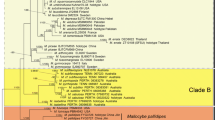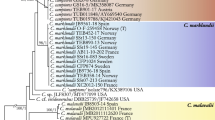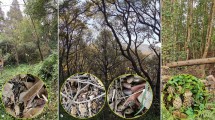Abstract
The genus Thelonectria and closely related species with cylindrocarpon-like asexual states are a group of perithecial ascomycetes in the family Nectriaceae that occur as saprobes and in few cases as pathogens of hardwood trees, shrubs or other plants. Although a key component of forest ecosystems around the world, species relationships and distributions of these fungi are largely unknown. The objectives of this study were to: 1) infer species rank phylogenetic relationships of the genus Thelonectria and closely related species with cylindrocarpon-like asexual states and test the monophyly of each of the groups studied; 2) delimit taxa establishing taxon circumscriptions; 3) resolve nomenclatural issues by identifying redundantly used names and synonyms; and 4) provide an updated outline to the genus, geographical distributions data and identification tools, specifically diagnostic keys and molecular data that can be used as molecular barcodes. The recovered consensus phylogeny resulted in a narrow circumscription of the genus Thelonectria, based on the type T. discophora, excluding one of the common species T. jungneri. According to the phylogenetic analyses, T. jungneri belongs in a segregate clade that should be recognized as a different genus. In the genus Thelonectria, a total of four new species and three new combinations are recognized. Additionally, three new genera, closely related to Thelonectria, are described to accommodate species displaying a morphological resemblance to those of Thelonectria: Cinnamomeonectria gen. nov. with C. cinnamomea as type species, Macronectria gen. nov. with M. jungneri as type species and including four additional newly described species, and Tumenectria gen. nov. with T. laetidisca as type species.



















Similar content being viewed by others
References
Booth C (1959) Studies of pyrenomycetes: IV. Nectria (part I). Mycol Pap 73:1–115
Booth C (1966) The genus Cylindrocarpon. Mycol Pap 104:1–56
Brayford D (1987) Cylindrocarpon olidum var. olidum. CMI descriptions of pathogenic fungi and bacteria. 929
Brayford D (1991) Compendium of raspberry and blackberry diseases and insects. American Phytopathological Society, St. Paul
Brayford D, Honda BM, Mantiri FR, Samuels GJ (2004) Neonectria and Cylindrocarpon: the Nectria mammoidea group and species lacking microconidia. Mycologia 96:572–597
Brayford D, Samuels GJ (1993) Some didymosporous species of Nectria with nonmicroconidial Cylindrocarpon anamorphs. Mycologia 85:612–637
Cabral A, Groenewald JZ, Rego C et al (2012) Cylindrocarpon root rot: multi-gene analysis reveals novel species within the Ilyonectria radicicola species complex. Mycol Prog 11:655–688
Carbone I, Kohn L (1999) A method for designing primer sets for speciation studies in filamentous ascomycetes. Mycologia 91:553–556
Castlebury L, Rossman AY, Sung G-H et al (2004) Multigene phylogeny reveals new lineage for Stachybotrys chartarum, the indoor air fungus. Mycol Res 108:864–872
Cedeño L, Carrero C, Quintero K et al (2004) Cylindrocarpon destructans var. destructans and Neonectria discophora var. rubi associated with black foot rot on blackberry (Rubus glaucus Benth.) in Venezuela. Interciencia 29:455–460
Chaverri P, Salgado C, Hirooka Y et al (2011) Delimitation of Neonectria and Cylindrocarpon (Nectriaceae, Hypocreales, Ascomycota) and related genera with cylindrocarpon-like anamorphs. Stud Mycol 68:57–78
Chaverri P, Vílchez B (2006) Hypocrealean (hypocreales, ascomycota) fungal diversity in different stages of tropical forest succession in Costa Rica. Biotropica 38:531–543
Christin PA, Weinreich DM, Besnard G (2010) Causes and evolutionary significance of genetic convergence. Trends Genet 26:400–405
Cracraft J (1983) Species concepts and speciation analysis. In: Johnston R (ed) Current ornithology. Springer US, pp 159–187
De Queiroz K (2007) Species concepts and species delimitation. Syst Biol 56:879–886
Debeaux O, Trabut A, Therry J et al (1880) Bouquet de champignons nouveaux observes dans le Midi de la France et en Algerue (1879–1880). Rev Mycol Toulouse 2:181–191
Dingley J (1951) The hypocreales of New Zealand II. The genus Nectria. Trans R Soc N Z 79:177–202
Farr DF, Rossman AY (2016) Fungal databases, Systematic Mycology and Microbiology Laboratory, ARS, USDA. Retrieved February 21, 2016, from http://nt.ars-grin.gov/fungaldatabases/
Gargas A, Taylor J (1992) Polymerase chain reaction (PCR) primers for amplifying and sequencing 18S rDNA from lichenized fungi. Mycologia 84:589–592
Guu JR, Ju YM, Hsieh HJ (2007) Nectriaceous fungi collected from forests in Taiwan. Bot Stud 48:187–203
Hawksworth DL, Crous PW, Redhead SA et al (2011) The Amsterdam declaration on fungal nomenclature. IMA Fungus 2:105–112
Hibbett D, Fukumasa-Nakai Y, Tsuneda A, Donoghue MJ (1995) Phylogenetic diversity in shiitake inferred from nuclear ribosomal DNA sequences. Mycologia 87:618–638
Hirooka Y, Kobayashi T, Natsuaki K, Aoki T (2006) Neonectria amamiensis and Cylindrocarpon amamiense, a new nectrioid fungus and its sporodochial anamorph in Pinus luchuensis from Japan. Mycoscience 47:248–256
Hirooka Y, Rossman AY, Chaverri P (2011) A morphological and phylogenetic revision of the Nectria cinnabarina species complex. Stud Mycol 68:35–56
Huelsenbeck J, Rannala B (2004) Frequentist properties of Bayesian posterior probabilities of phylogenetic trees under simple and complex substitution models. Syst Biol 53:904–913
Jones MD, Richards TA, Hawksworth DL, Bass D (2011) Validation and justification of the phylum name Cryptomycota phyl. nov. IMA Fungus 2:173–175
Linde CC, Phillips RD, Crisp MD, Peakall R (2014) Congruent species delineation of Tulasnella using multiple loci and methods. New Phytol 201:6–12
Liu K, Warnow TJ, Holder MT et al (2012) SATé-II: very fast and accurate simultaneous estimation of multiple sequence alignments and phylogenetic trees. Syst Biol 61:90–106
Liu YJ, Whelen S, Hall BD (1999) Phylogenetic relationships among ascomycetes: evidence from an RNA polymerse II subunit. Mol Biol Evol 16:1799–1808
Lombard L, Van Der Merwe NA, Groenewald JZ, Crous PW (2015) Generic concepts in Nectriaceae. Stud Mycol 80:189–245
Lombard L, Van Der Merwe NA, Groenewald JZ, Crous PW (2014) Lineages in Nectriaceae: re-evaluating the generic status of Ilyonectria and allied genera. Phytopathol Mediterr 53:515–532
Meirmans PG (2012) The trouble with isolation by distance. Mol Ecol 21:2839–2846
Miyauchi R, Takatsu T, Suzuki T et al (2015) Biosynthesis of nectrisine in Thelonectria discophora SANK 18292. Phytochemistry 116:87–93
Moen DS, Irschick DJ, Wiens J (2013) Evolutionary conservatism and convergence both lead to striking similarity in ecology, morphology and performance across continents in frogs. Proc R Soc B Biol Sci 280:20132156
Moncalvo J-M, Lutzoni FM, Rehner SA, Johnson J, Vilgalys R (2000) Phylogenetic relationships of agaric fungi based on nuclear large subunit ribosomal DNA sequences. Syst Biol 49:278–305
Nirenberg H (1976) Untersuchungen uber die morphologische und biologische Differenzierung in der Fusarium-Sektion Liseola. Mitt Biol Bundesanst Land- Forstw Berlin-Dahlem 169:1–117
Nirma C, Stien D, Institut C et al (2015) Antibacterial Ilicicolinic Acids C and D and Ilicicolinal from Neonectria. J Nat Prod 78:159–162
Nygren K, Strandberg R, Wallberg A et al (2011) A comprehensive phylogeny of Neurospora reveals a link between reproductive mode and molecular evolution in fungi. Mol Phylogenet Evol 59:649–663
O’Donnell K, Cigelnik E (1997) Two divergent intragenomic rDNA ITS2 types within a monophyletic lineage of the fungus Fusarium are nonorthologous. Mol Phylogenet Evol 7:103–116
Osono T, Takeda H (2002) Comparison of litter decomposing ability among diverse fungi in a cool temperate deciduous forest in Japan. Mycologia 94:421–427
Posada D (2008) jModelTest: phylogenetic model averaging. Mol Biol Evol 25:1253–1256
Price MN, Dehal PS, Arkin AP (2010) FastTree 2 - approximately maximum-likelihood trees for large alignments. PLoS One 5:e9490
Rambaut A (2014) FigTree v1.4.2. http://tree.bio.ed.ac.uk/software/figtree
Rambaut A, Suchard M, Xie D, Drummond A (2014) Tracer v1.6. http://beast.bio.ed.ac.uk/Tracer
Rayner R (1970) A mycological colour chart. Commonwealth Mycological Institute, Kew
Ronquist F, Huelsenbeck JP (2003) MrBayes 3: Bayesian phylogenetic inference under mixed models. Bioinformatics 19:1572–1574
Rossman A (1983) The phragmosporous species of Nectria and related genera. Mycol Pap 150:1–164
Rossman AY, Seifert KA, Samuels GJ et al (2013) Genera in bionectriaceae, hypocreaceae, and nectriaceae (Hypocreales) proposed for acceptance or rejection. IMA Fungus 4:41–51
Salgado-Salazar C, Chaverri P, Rossman A et al (2012) Multigene phylogenetic analyses of the Thelonectria coronata and T. veuillotiana species complexes. Mycologia 104:1325–1350
Salgado-Salazar C, Rossman AY, Chaverri P (2013) Not as ubiquitous as we thought: taxonomic crypsis, hidden diversity and cryptic speciation in the cosmopolitan fungus Thelonectria discophora (Nectriaceae, Hypocreales, Ascomycota). PLoS One 8:e76737
Salgado-Salazar C, Rossman A, Samuels G et al (2015) Phylogeny and taxonomic revision of Thelonectria discophora (Ascomycota, Hypocreales, Nectriaceae) species complex. Fungal Divers 70:1–29
Samuels G, Brayford D (1993) Phragmosporous Nectria species with Cylindrocarpon anamorphs. Sydowia 45:55–80
Samuels G, Brayford D (1994) Species of Nectria (sensu lato) with red perithecia and striate ascospores. Sydowia 46:75–161
Samuels G, Doi Y, Rogerson C (1990) Contributions toward a mycobiota of Indonesia: Hypocreales, synnematous Hyphomycetes, Aphyllophorales, Phragmobasidiomycetes, and Mixomycetes. New York Botanical Garden, New York
Samuels GJ, Dodd S, Lu BS et al (2006) The Trichoderma koningii aggregate species. Stud Mycol 56:67–133
Seifert K, Rossman AY (2010) How to describe a new fungal species informal requirements. IMA Fungus 1:109–116
Silvestro D, Michalak I (2012) RaxmlGUI: a graphical front-end for RAxML. Org Divers Evol 12:335–337
Singhal S, Moritz C (2013) Reproductive isolation between phylogeographic lineages scales with divergence. Proc Biol Sci 280:20132246
Sites JW, Marshall JC (2003) Delimiting species: a Renaissance issue in systematic biology. Trends Ecol Evol 18:462–470
Stamatakis A (2006) RAxML-VI-HPC: maximum likelihood-based phylogenetic analyses with thousands of taxa and mixed models. Bioinformatics 22:2688–2690
Talavera G, Castresana J (2007) Improvement of phylogenies after removing divergent and ambiguously aligned blocks from protein sequence alignments. Syst Biol 56:564–577
Tamura K, Stecher G, Peterson D, Filipski A, Kumar S (2013) MEGA6: molecular evolutionary genetics analysis version 6.0. Mol Biol Evol 30:2725–2729
Taylor JW, Jacobson DJ, Kroken S et al (2000) Phylogenetic species recognition and species concepts in fungi. Fungal Genet Biol 31:21–32
Taylor JW, Turner E, Townsend JP et al (2006) Eukaryotic microbes, species recognition and the geographic limits of species: examples from the kingdom Fungi. Philos Trans R Soc Lond B Biol Sci 361:1947–1963
Vilgalys R, Hester M (1990) Rapid genetic identification and mapping of enzymatically amplified ribosomal DNA from several Cryptococcus species. J Bacteriol 172:4238–4246
White T, Bruns T, Lee S, Taylor J (1990) Amplification and direct sequencing of fungal ribosomal RNA genes for phylogenetics. In: Innis M, Gelfand D, Sninsky J, White T (eds) PCR protocols: a guide to methods and applications. Academic Press, Inc., New York, pp 315–322
Wu M, Chatterji S, Eisen JA (2012) Accounting for alignment uncertainty in phylogenomics. PLoS One 7:1–10
Zeng ZQ, Zhuang WY (2013) Four new taxa of Ilyonectria and Thelonectria (Nectriaceae) revealed by morphology and combined ITS and B-tubulin sequence data. Phytotaxa 85:15–25
Acknowledgments
This study was funded by a grant from United States National Science Foundation (PEET program) DEB-0925696: “Monographic Studies in the Nectriaceae, Hypocreales: Nectria, Cosmospora, and Neonectria” to University of Maryland (P. Chaverri, G.J. Samuels & A.Y. Rossman). We are indebted to the Genetic Resources Collection at CABI UK for providing cultures. Dr. Christian Lechat (AscoFrance) shared several specimens and cultures from French Guiana, Dr. Carlos Mendez (University of Costa Rica) helped with transportation during collecting trips in Costa Rica, Dr. Andrea I. Romero offered invaluable assistance during fieldwork in Argentina, Dr. Teresa Iturriaga organized the collecting trip in Venezuela, Dr. Olinto Liparini Pereira collaborated during the collecting trip in Brazil and Dr. Guu provided specimens and cultures from Taiwan. Much gratitude is also extended to Tunesha Phipps at the Systematic Mycology and Microbiology Laboratory for assistance with sequencing procedures. CS-S wants to express her gratitude towards Dr. Gary J. Samuels for sharing his inmense knowledge about nectriaceous fungi, helping us to love, cheer and always be amazed by these “little red fungi”.
Author information
Authors and Affiliations
Corresponding author
Electronic supplementary material
Below is the link to the electronic supplementary material.
Online Resource 1
(DOCX 236 kb)
Online Resource 2
(PDF 264 kb)
Rights and permissions
About this article
Cite this article
Salgado-Salazar, C., Rossman, A.Y. & Chaverri, P. The genus Thelonectria (Nectriaceae, Hypocreales, Ascomycota) and closely related species with cylindrocarpon-like asexual states. Fungal Diversity 80, 411–455 (2016). https://doi.org/10.1007/s13225-016-0365-x
Received:
Accepted:
Published:
Issue Date:
DOI: https://doi.org/10.1007/s13225-016-0365-x




